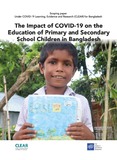| dc.contributor.author | Hossain, Marjan | |
| dc.contributor.author | Wahedur Rahman, Khandker | |
| dc.coverage.spatial | Bangladesh | en |
| dc.date.accessioned | 2022-09-22T12:59:07Z | |
| dc.date.available | 2022-09-22T12:59:07Z | |
| dc.date.issued | 2022-03-31 | |
| dc.identifier.citation | Hossain, M. and Wahedur Rahman, K. (2022) 'The Impact of COVID-19 on the Education of Primary and Secondary School Children in Bangladesh', Scoping Paper, Dhaka: BRAC Institute of Governance and Development (BIGD) | en |
| dc.identifier.uri | https://opendocs.ids.ac.uk/opendocs/handle/20.500.12413/17651 | |
| dc.description.abstract | As a part of its pandemic response strategy, Bangladesh declared school shutdowns on March 17,
2020, and maintained them for 18 months1
, making it one of the world's longest-running pandemicrelated school closures (GEEAP, 2022). On January 21, 2022, in-person classes were suspended for a
month to combat the omicron variant's escalating infection rates (GEEAP, 2022). As a result, the
learning activities of approximately 30 million primary and secondary school students in Bangladesh
have been disrupted. (BANBEIS, 2020).
Bangladesh was struggling with a learning crisis even before the COVID-19 outbreak (World Bank,
2017). Test scores from various learning assessments indicated that children at primary and secondary
levels were performing significantly below their core grade-level competencies (MoPME, 2017; UNICEF
& BBS, 2019; BRAC-IID, 2015). Disengagement from learning due to extended school closures is
predicted to have a detrimental effect on children's learning gains (Vegas, 2021), and if the potential
implications of COVID-19 on an education system already plagued by shallow schooling-learning
profiles are considered (Bhatta & Sharma, 2019; Asaduzzaman & Shams, 2019, Asadullah & Chaudhury,
2015), the pre-pandemic learning crisis is expected to deteriorate even further. Children from affluent
families, living in urban residences or those with more educated parents are likely to be better
prepared when classes resume, whereas underprivileged/marginalised children are more likely to fall
behind academically (Angrist et al., 2021; Andrabi et al., 2020; UNICEF & UNESCO, 2021). Hence,
students will be returning to school with differing levels of learning gaps, depending on how effectively
they were supported and remained engaged in learning during school closures. | en |
| dc.language.iso | en | en |
| dc.publisher | BRAC Institute of Governance and Development (BIGD) | en |
| dc.rights.uri | http://creativecommons.org/licenses/by/4.0/ | en |
| dc.subject | Children and Youth | en |
| dc.subject | Education | en |
| dc.subject | Health | en |
| dc.title | The Impact of COVID-19 on the Education of Primary and Secondary School Children in Bangladesh | en |
| dc.type | Other | en |
| dc.rights.holder | BRAC Institute of Governance and Development (BIGD) | en |
| dc.identifier.externaluri | https://bigd.bracu.ac.bd/publications/the-impact-of-covid-19-on-the-education-of-primary-and-secondary-school-children-in-bangladesh/ | en |
| rioxxterms.funder | Default funder | en |
| rioxxterms.identifier.project | Default project | en |
| rioxxterms.version | VoR | en |
| rioxxterms.funder.project | 9ce4e4dc-26e9-4d78-96e9-15e4dcac0642 | en |


